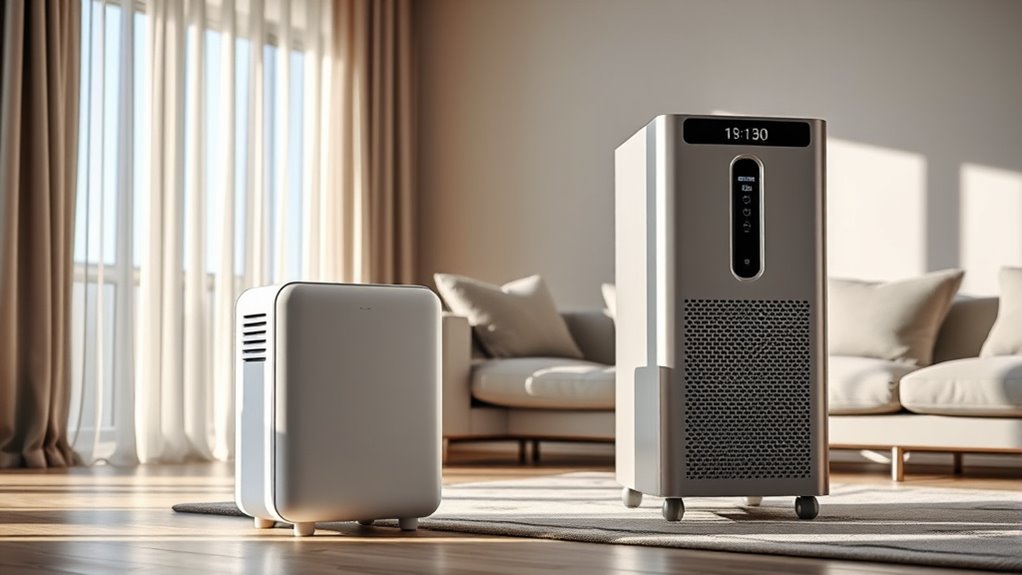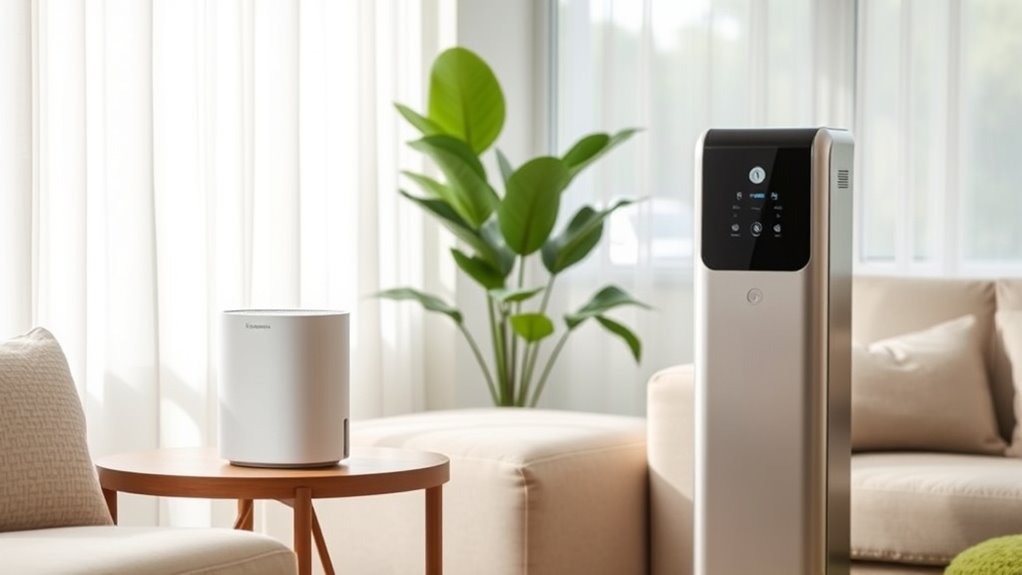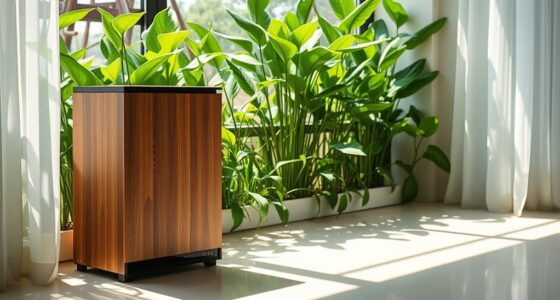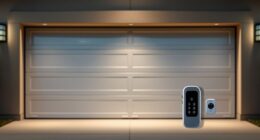If you need flexibility and want to move your air purifier between rooms, a portable model is your best choice since it’s lightweight and easy to relocate. However, if you prefer a dedicated, powerful solution for a large or consistent space, a stationary purifier offers better performance and longer filter life. Think about your space, needs, and noise preferences. For more details, explore which option fits your lifestyle and environment best.
Key Takeaways
- Portable units are ideal for flexible, quick air quality improvements across multiple spaces; stationary purifiers suit fixed, long-term setups.
- Portable models are compact and lightweight, while stationary units are larger and more powerful for bigger rooms.
- Portable air purifiers operate quietly and are easy to move, whereas stationary models may produce more noise but offer continuous filtration.
- Stationary purifiers typically have larger filters with longer lifespans, reducing maintenance frequency compared to portable units.
- Choose portability for versatile use; opt for stationary units if you prioritize consistent, high-capacity air purification in a dedicated space.

When choosing an air purifier, understanding the differences between portable and stationary models is essential to find the right fit for your space and needs. Your decision will impact not only how well the device improves your air quality but also how it fits into your daily routine. Portable air purifiers are designed for flexibility, allowing you to move them easily from room to room. This mobility is ideal if you want to target multiple spaces or need a device that adapts to your changing environment. They’re typically smaller, lightweight, and often come with handles or wheels, making them simple to relocate. Because of their size, they usually have smaller filters, which means you may need to replace or clean the filter more frequently. However, their compact nature means they usually operate quietly, minimizing noise levels and allowing you to enjoy a peaceful environment.
In contrast, stationary air purifiers stay fixed in a single location, often mounted on a wall or placed on the floor. These models tend to be larger and more powerful, making them suitable for larger rooms or spaces where consistent air filtration is necessary. Since stationary units are designed for long-term placement, they often feature larger filters that last longer and provide more thorough purification. This can lead to improved air quality, especially in spaces with high pollution levels or allergens. However, because of their size and design, stationary purifiers can generate higher noise levels, which might be noticeable if you’re sensitive to sound or trying to sleep. Despite this, many newer models incorporate noise reduction technology, helping to keep operation relatively quiet.
Your choice also depends on your priorities regarding air quality and noise levels. If you want a device that’s easy to move around and can be used in various rooms, a portable purifier is often the better choice. They’re convenient for quick air quality boosts in different areas of your home or office. On the other hand, if you’re looking to improve air quality in a dedicated space, such as a living room or bedroom, and prefer a more powerful, long-term solution, a stationary model might be more suitable. Consider how much space you have, your sensitivity to noise, and how often you want to change filters. Additionally, understanding the filtration technologies used, such as HEPA filters, can help you choose a device with optimal allergen removal capabilities. Ultimately, both types can effectively improve air quality, but your specific needs and environment will guide you toward the right option.
Frequently Asked Questions
Can Portable Air Purifiers Effectively Clean Large Rooms?
Portable air purifiers can effectively clean large rooms if they have sufficient large room coverage and good air circulation efficiency. Look for models with higher CADR ratings and a powerful fan to guarantee the air is circulated and filtered properly. While smaller units work well in compact spaces, choose a portable purifier designed for large rooms to maintain clean, fresh air throughout the entire space.
Do Stationary Air Purifiers Require Professional Installation?
Did you know that 60% of stationary air purifiers require professional installation due to setup complexity? You don’t have to worry about this process yourself, as most models demand expert help for proper setup. If you prefer a hassle-free experience, portable units are easier to move and install without professional assistance. However, stationary purifiers might offer better coverage, so weigh installation requirements against your needs before deciding.
How Often Do Filters Need Replacement in Each Type?
You’ll need to replace filters more frequently in portable air purifiers, typically every 3 to 6 months, depending on usage and filter type. Stationary units often have longer filter lifespans, usually lasting 6 to 12 months. Keep an eye on the replacement indicator or check the manufacturer’s recommended replacement frequency to maintain excellent air quality. Regular filter changes ensure your purifier remains effective and prolong its lifespan.
Are There Noise Level Differences Between Portable and Stationary Purifiers?
Surprisingly, noise levels can vary more within each type than between portable and stationary purifiers. You’ll find some portable units whisper quietly, while others produce more noticeable sound levels, especially on higher settings. Stationary purifiers often operate more quietly, but not always. So, when comparing noise, check the sound levels—don’t assume one type is inherently quieter. You might end up choosing based on sound comparison, not just portability.
Which Type Is More Energy-Efficient for Long-Term Use?
Stationary air purifiers tend to be more energy-efficient for long-term use because they generally have larger motors and higher power efficiency, covering bigger areas with less energy. Portable units use less energy per hour but might consume more overall if you need multiple units for larger spaces. If you prioritize overall energy consumption and power efficiency, a stationary purifier is often the smarter choice for sustained use.
Conclusion
Think of portable air purifiers as your trusty sidekick, ready to follow you from room to room, while stationary units stand like guardians, steadfast in one place. Your choice depends on whether you want flexibility or a dedicated haven. Just as a lighthouse guides ships safely to shore, pick the purifier that best illuminates your space’s air quality needs. Whichever you choose, breathe easier knowing you’re making a smart, proactive decision.









